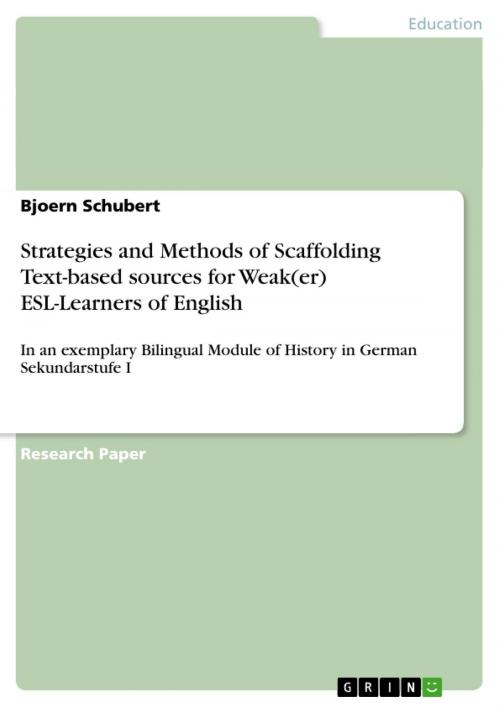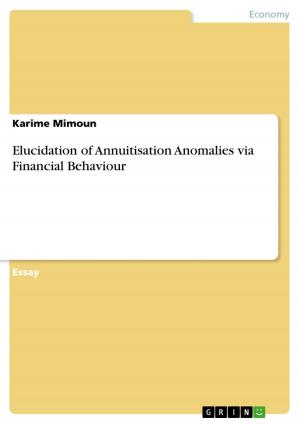Strategies and Methods of Scaffolding Text-based sources for Weak(er) ESL-Learners of English
In an exemplary Bilingual Module of History in German Sekundarstufe I
Nonfiction, Reference & Language, Study Aids, ESL, Foreign Languages| Author: | Bjoern Schubert | ISBN: | 9783656634812 |
| Publisher: | GRIN Publishing | Publication: | April 11, 2014 |
| Imprint: | GRIN Publishing | Language: | English |
| Author: | Bjoern Schubert |
| ISBN: | 9783656634812 |
| Publisher: | GRIN Publishing |
| Publication: | April 11, 2014 |
| Imprint: | GRIN Publishing |
| Language: | English |
Research Paper (postgraduate) from the year 2013 in the subject English - Pedagogy, Didactics, Literature Studies, grade: 2,0, Humboldt-University of Berlin (Anglistik und Amerikanistik), course: Bilingualer Sachfachunterricht als content and language integrated learning (CLIL), language: English, abstract: In this paper, I wish to explore and apply a selected range of the possible strategies and methods of scaffolding text-based sources for weaker learners, or learners simply not as privileged by their social background. If one looks at the present educational landscape of Berlin one will come across a selection of bilingual schools: Ones where native speakers teach nearly the entire curriculum in English, and a large range of schools offering bilingual classes or modules. The majority of schools still do not offer any bilingual education opportunities.2 Therefore, the benefits of bilingual education (German-English) seem to be only for privileged students (cf. Zydatiß 2007), though there are a few exceptions throughout Germany. (Cf. Rabe 2013) The overall amount material available for bilingual education and the teachers being educated for it are still a small portion in comparison to the overall amount of material and teachers available in both English and History (monolingual German) in primary and secondary school curriculum. The actual material being published often still lacks the degree of text-based scaffolding described in theory by Pilzecker (1997a) and Wildhage (2003). Interestingly, many ordinary textbooks of English now offer very brief bilingual modules. The first part of this paper briefly explores some of the linguistic background of scaffolding text-based material in bilingual teaching of history in German Sekundarstufe 1. In the second part of this paper, I will apply my findings to a short bilingual module offered in a contemporary textbook English G21 D4 [year 8] Erweiterte Ausgabe by the German textbook publishing company Cornelsen. Looking at a bilingual module in this exemplary textbook G21 one wonders how much language-related scaffolding was included by the editors due to the real didactical needs of the learners and might have been left out in the process of laying out the textbook and the limitations of space in a due to content?
Research Paper (postgraduate) from the year 2013 in the subject English - Pedagogy, Didactics, Literature Studies, grade: 2,0, Humboldt-University of Berlin (Anglistik und Amerikanistik), course: Bilingualer Sachfachunterricht als content and language integrated learning (CLIL), language: English, abstract: In this paper, I wish to explore and apply a selected range of the possible strategies and methods of scaffolding text-based sources for weaker learners, or learners simply not as privileged by their social background. If one looks at the present educational landscape of Berlin one will come across a selection of bilingual schools: Ones where native speakers teach nearly the entire curriculum in English, and a large range of schools offering bilingual classes or modules. The majority of schools still do not offer any bilingual education opportunities.2 Therefore, the benefits of bilingual education (German-English) seem to be only for privileged students (cf. Zydatiß 2007), though there are a few exceptions throughout Germany. (Cf. Rabe 2013) The overall amount material available for bilingual education and the teachers being educated for it are still a small portion in comparison to the overall amount of material and teachers available in both English and History (monolingual German) in primary and secondary school curriculum. The actual material being published often still lacks the degree of text-based scaffolding described in theory by Pilzecker (1997a) and Wildhage (2003). Interestingly, many ordinary textbooks of English now offer very brief bilingual modules. The first part of this paper briefly explores some of the linguistic background of scaffolding text-based material in bilingual teaching of history in German Sekundarstufe 1. In the second part of this paper, I will apply my findings to a short bilingual module offered in a contemporary textbook English G21 D4 [year 8] Erweiterte Ausgabe by the German textbook publishing company Cornelsen. Looking at a bilingual module in this exemplary textbook G21 one wonders how much language-related scaffolding was included by the editors due to the real didactical needs of the learners and might have been left out in the process of laying out the textbook and the limitations of space in a due to content?















